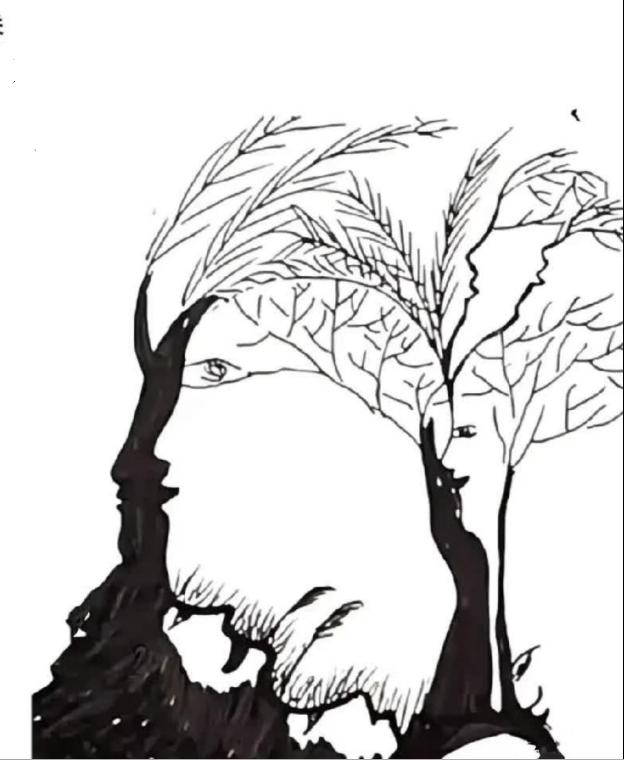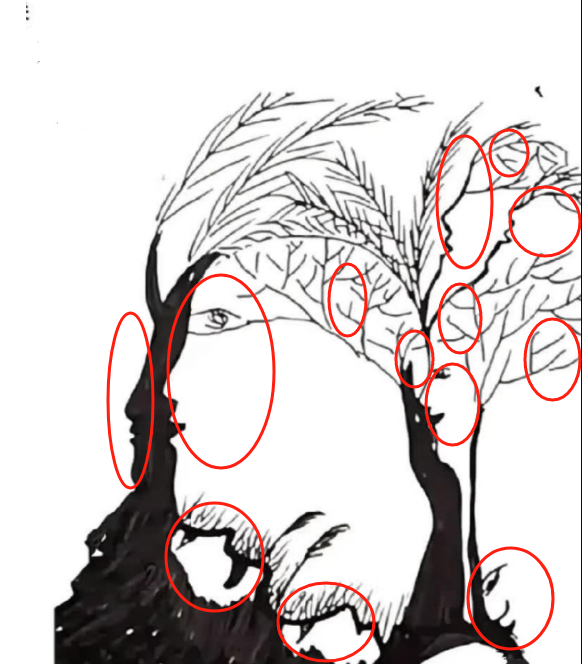Faces in the Forest: Exploring the Art and Psychology of Tree Illusions
The Magnetic Pull of Nature’s Hidden Faces
Have you ever wandered through a woodland, only to swear you’ve spotted a mysterious face carved into the bark of an old oak? That uncanny mix of familiarity and surprise is the essence of pareidolia—the human brain’s penchant for seeing patterns where none were intentionally placed. In this captivating illustration, gnarled tree trunks seamlessly morph into a thoughtful human profile, complete with a watchful eye and flowing hair made of slender branches. This optical illusion art harnesses the magic of nature and psychology to create an unforgettable visual puzzle—but why are we so drawn to these hidden visages?

Understanding Pareidolia: Why Our Minds Seize on Faces
Pareidolia springs from our evolutionary wiring. Spotting faces quickly—whether friend or foe—was a survival advantage for early humans. By interpreting random stimuli as human shapes, our ancestors could recognize allies, predators, or potential threats in the blink of an eye. Today, this hardwired bias persists:
- Facial Recognition Networks: Neuroscientists have pinpointed neurons in the fusiform face area of the brain that fire vigorously at face-like patterns.
- Emotional Resonance: Faces carry emotional weight; a fleeting glimpse of two eyes and a mouth triggers empathy, curiosity, or even unease.
- Artistic Allure: Artists exploit this quirk, embedding hidden profiles in landscapes or still lifes to engage viewers on both conscious and subconscious levels.
So when you first glance at the tree silhouette and see only bark, then suddenly “hear” a face calling out, you’re experiencing a deeply human phenomenon.
Crafting the Illusion: Artist Techniques Revealed
Transforming everyday tree shapes into a convincing human profile requires skillful design:
- Strategic Silhouette: The artist begins by outlining a human face—forehead, nose, lips, chin—and then weaves tree trunks and branches around that contour.
- Negative Space Mastery: Empty spaces between limbs become facial features—an eye here, a cheek curve there—inviting the brain to complete the picture.
- Texture Consistency: Bark patterns and branch lines mimic skin creases and hair strands, ensuring both elements share a visual language.
- Minimalist Color Palette: A stark black-and-white or muted monochrome scheme focuses attention on shapes rather than distracting hues.
By blending these tactics, the illusion holds up under scrutiny. Viewers find themselves flipping between seeing “just a tree” and “a hidden face,” often unable to settle on one interpretation.

The Psychology of Double Vision: Embracing Ambiguity
Why does this creative play on perception feel so satisfying? Because it engages two cognitive processes at once:
- Pattern Matching: Your visual system hunts for familiar shapes—eyes, nose, mouth—amid the random branches.
- Gestalt Integration: Your brain binds those features into a coherent whole: a human visage emerges.
This push-and-pull between detail focus and holistic assembly creates a mental tug-of-war, triggering delight when the hidden image snaps into view. It’s akin to solving a puzzle, but the solution unfolds spontaneously in your own mind.
Historical Roots: Faces in Trees Through the Ages
While our featured artwork feels fresh, the concept of hidden faces in trees has deep roots:
- Celtic Mythology: Ancient Druids believed certain trees housed spirits; carvings of human-like faces on trunks honored these protectors.
- Romantic Landscape Painting: 19th-century artists like John Martin occasionally embedded faint facial profiles in clouds and foliage to evoke mystical themes.
- Modern Surrealism: Salvador Dalí and René Magritte played with double images—rock formations or tree silhouettes doubling as faces—inviting viewers to question reality.
By tapping into this lineage, today’s artists continue to celebrate the interplay between the natural world and human imagination.

Creating Your Own Tree Face Illusion
Want to craft a pareidolic masterpiece? Follow these simple steps:
- Start with a Profile Sketch: Lightly draw a side-view of a face on paper or digitally.
- Overlay Branch Patterns: Using organic, irregular lines, build tree trunk shapes around your profile—let branches flow like hair.
- Define Key Features with Negative Space: Carve out eye sockets, nostrils, and lips by leaving gaps between limbs.
- Match Textures: Mimic bark grain with fine crosshatching or stippling in shaded areas.
- Refine and Simplify: Remove any superfluous lines that distract from the illusion. Focus on clarity at the silhouette edges.
Practicing this technique yields a series of enchanting images that playfully tease your viewer’s perception.
Why Hidden Faces Enhance Engagement
In an age of fleeting digital attention, artworks that hide secret images spark curiosity and prolong viewer engagement. Brands, educators, and social media influencers harness these illusions to:
- Boost Shareability: Audiences love tagging friends in “Can you see it?” challenges.
- Encourage Replay: Viewers return multiple times, each scan revealing new details.
- Foster Conversation: Debates over “Where’s the eye?” or “Is that a mouth?” build community interaction.
Whether used in marketing visuals or classroom activities, hidden-face art captivates more effectively than straightforward imagery.

Beyond Faces: Other Pareidolic Wonders in Nature
Pareidolia isn’t confined to trees. Keep your eyes peeled for:
- Cloud Animals: Horses, dragons, or whales drift across the sky, prompting sky-gazing reveries.
- Rock Formations: Mountains and boulders sculpted by erosion often mimic familiar shapes—a human face peering over a cliff, for instance.
- Leaf Vein Patterns: Intricate vein networks can suggest rivers on a map or neural pathways in the brain.
Developing a pareidolic eye turns everyday scenes into treasure hunts, heightening your connection to the world around you.

Conclusion: Celebrating the Dance of Perception
That evocative illustration—a tree’s silhouette doubling as a human profile—reminds us of the delicate dance between external stimuli and internal interpretation. By understanding pareidolia, exploring artistic methods, and recognizing our innate urge to find faces, we enrich our appreciation for both art and nature. So next time you stroll through a grove or gaze at a simple sketch, keep your mind open: you might just discover a hidden spirit smiling back at you through branches and bark.





